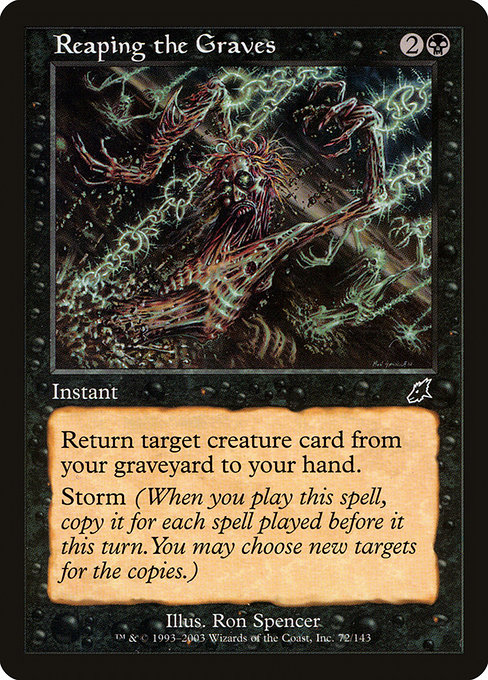
Image courtesy of Scryfall.com
Legacy and Luster: Reaping the Graves in MTG Fandom
In the shadowed corners of black mana and graveyard strategies, Reaping the Graves has long held a quiet, persistent glow. Released as part of Scourge in 2003, this common instant isn’t flashy at first glance: for two mana and a black mana, you get to return a creature card from your graveyard to your hand. It’s the type of spell that players underestimate until the storms of the format turn treacherous and the game hinges on a single moment of recursion 🧙♂️. Yet look closer, and you see a card that embodies a certain MTG ethos: graveyard resilience, a touch of tempo, and a spellcasting mentality that rewards careful sequencing and timing.
What elevates Reaping the Graves in fandom chatter isn’t just its effect, but its Storm keyword. Storm turns this modest interruption into a potential windfall by duplicating it for each spell cast earlier in the turn. In Legacy, where multi-spell turns are a known quantity, the spell invites a philosophical debate about what it means to “build” a turn. Do you lean into a full-on storm shell with cheap cantrips and rituals? Or do you slot this into a more conservative graveyard toolbox, using it as a bridge to reestablish a plan after a disruption? The conversations you’ll find in MTG forums, blogs, and decklists alike often circle back to this dual identity: a card that can quietly loom large in the right moment, yet stays accessible and thematic as a common in the Scourge era 🧠🔥.
“Sometimes the smallest card with a big storm can tilt the entire table toward your side.” — a sentiment you’ll hear echoed in many Legacy matchups where Reaping the Graves sits in the middle of the table’s attention, waiting for the moment to strike 💎⚔️.
Storm, Recursion, and the Fandom Narrative
Storm was one of Magic’s most evocative mechanics in the late 90s and early 2000s, a concept that felt both magical and mathematical. Reaping the Graves taps into that vibe by offering a path to reuse a critical piece from your graveyard—the creatures that have already paid their dues and now might return to the fray with a refreshed purpose. InLegacy circles, that rhythm is everything: you’re measuring tempo, card advantage, and the probability of drawing into your answer or your lethal finisher. The art of a good storm turn is less about raw power and more about the story you tell—the chain of events, the choices you make, and the way your opponent reads your deck’s intentions. Reaping the Graves embodies that narrative in a few syllables and a handful of mana 🧭🎲.
Beyond Legacy, the card’s standing in fandom is also colored by its artwork, rarity, and role in print history. Ron Spencer’s illustration brings a moody, graveyard-forward aesthetic that fans resonate with when discussing the Scourge block. The set itself marked a transitional period for MTG, bridging newer mechanical ambitions with classic graveyard themes. Even as the format evolved, players revisited Reaping the Graves to demonstrate how a single, well-timed spell could change the pace of a game, especially when fear of the graveyard’s reach loomed large in the matchup 🔮🎨.
Practical Takeaways for Modern Players
- Target selection matters. Since you’re returning a creature from graveyard to hand, you’ll want to consider which creature’s basest power, activated ability, or late-game impact is most relevant to your current strategy. In Legacy, that often means prioritizing creatures that synergize with bog-standard graveyard hate or that set up a back-up plan after a disruption.
- Storm balance. While Storm can amplify the spell, you don’t want to overcommit. If you’re sitting on a handful of cantrips, Reaping the Graves can become a powerful backup play, but you’ll want to ensure your storm count isn’t so high that you’ll glaze over the need to answer opposing threats later in the turn.
- Graveyard resilience. Cards that interact with the graveyard—both in your deck and in your opponent’s—shape how often Reaping the Graves becomes a meaningful tempo play. It’s a reminder that in Legacy, the graveyard isn’t just a resource for you; it’s a battlefield with competing claims.
- Aesthetics and value. Although Reaping the Graves is a common, its foil versions from certain printings carry collector appeal. The card’s price tag on the secondary market tends to reflect demand for nostalgia and the broader storm-era flavor rather than raw competitiveness—the sort of dynamic that fans love to debate 🌟💎.
For collectors and deck-designers alike, the card’s legacy is less about being a marquee finisher and more about its enduring role as a reminder that MTG is a game of layers. The interplay between graveyard mechanics, storm scaling, and the simple joy of returning a creature to hand creates a micro-legend within the broader MTG tapestry. It’s a card that invites stories—of late-night testing sessions, of a single line in a match that decided everything, of a forum post that sparked a new deck idea 🧙♂️🔥.
As you plan your own vintage or casual journeys, consider how Reaping the Graves could fit into a thoughtful Legacy lineup. It’s not about the loudest play in the room; it’s about the quiet, confident read of the table and the satisfying moment when your hand reappears with a familiar, even beloved creature ready to rejoin the fray ⚔️.
Meanwhile, if you’re diving into MTG fandom with a broader collector’s mindset, you’ll enjoy how this card threads through commentary about storm decks, graveyard-shifted strategies, and the evolving perception of common cards that punch above their weight. The legacy of Reaping the Graves in fandom is a testament to how a seemingly modest spell can command respect when placed in the right context—and when surrounded by a community that loves parsing the subtleties of card design and historical arcs 🧙♀️🎲.
Slim phone case for iphone 16 glossy lexan ultra-thinMore from our network
- https://blog.digital-vault.xyz/blog/post/weaving-mtg-lore-continuity-across-related-cards-half-shark/
- https://blog.digital-vault.xyz/blog/post/crafting-professional-portfolio-templates-that-convert/
- https://blog.digital-vault.xyz/blog/post/hidden-details-in-lurking-lizards-artwork-mtg-easter-eggs/
- https://transparent-paper.shop/blog/post/hot-o-star-illuminates-the-milky-way-in-3d/
- https://crypto-acolytes.xyz/blog/post/score-cheap-deals-through-game-trading-communities/